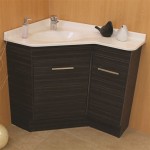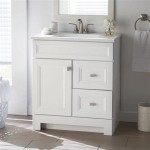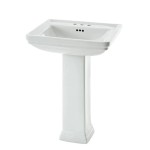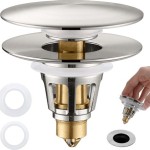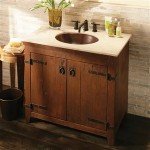Bathroom Vanity and Cabinet Sets: A Comprehensive Guide
Bathroom vanity and cabinet sets represent a significant investment in both the functionality and aesthetics of a bathroom space. These sets typically comprise a vanity unit, which houses the sink, and coordinating cabinets for storage, often including wall-mounted cabinets, linen towers, or base cabinets beyond the vanity itself. The coordinated design and integrated storage solutions offer a cohesive and efficient approach to bathroom remodeling or construction.
The selection of the appropriate bathroom vanity and cabinet set requires careful consideration of several factors, including bathroom size, desired style, storage needs, and budget. Understanding the various materials, styles, and configurations available is crucial for making an informed decision that aligns with individual preferences and practical requirements.
This guide aims to provide a comprehensive overview of bathroom vanity and cabinet sets, covering various aspects such as types, materials, design considerations, installation, and maintenance. It serves as a resource for homeowners, contractors, and designers seeking to navigate the complexities of selecting and implementing these essential bathroom components.
Key Considerations Before Purchasing a Bathroom Vanity and Cabinet Set
Before embarking on the purchasing process, several key considerations should be addressed to ensure a successful outcome. These include assessing the available space, determining storage needs, and establishing a budget.
Space Assessment: Thoroughly measure the bathroom area to determine the maximum dimensions for the vanity and cabinet set. Consider the placement of existing plumbing, electrical outlets, and other fixtures. Ensure adequate clearance for doors and drawers to open and close freely. Pay attention to the flow of traffic within the bathroom to avoid obstructions. For smaller bathrooms, wall-mounted vanities and compact cabinet configurations can maximize floor space and create a more open feel.
Storage Needs: Evaluate current storage requirements and anticipate future needs. Consider the types of items to be stored, such as toiletries, towels, cleaning supplies, and personal care products. Determine the optimal configuration of drawers, shelves, and cabinets to accommodate these items efficiently. Consider incorporating organizational accessories, such as drawer dividers and pull-out shelves, to maximize storage capacity and accessibility. For larger families or bathrooms with limited closet space, larger vanities with multiple drawers and cabinets, coupled with complementary linen towers, may be necessary.
Budget Allocation: Establish a realistic budget for the vanity and cabinet set, considering not only the purchase price but also installation costs and potential plumbing or electrical modifications. Research different brands and retailers to compare pricing and features. Be prepared to make compromises on certain features or materials to stay within budget. Consider the long-term value and durability of the materials chosen to ensure a worthwhile investment. Remember that installation costs can vary significantly depending on the complexity of the project and the contractor hired.
Materials Used in Bathroom Vanity and Cabinet Sets
The choice of materials significantly impacts the durability, aesthetics, and cost of bathroom vanity and cabinet sets. Common materials include wood, laminate, MDF (Medium-Density Fiberboard), and metal, each offering distinct advantages and disadvantages.
Wood: Solid wood is a premium material known for its natural beauty, durability, and longevity. Popular wood species for bathroom vanities and cabinets include oak, maple, cherry, and walnut. Solid wood is resistant to warping and cracking but requires proper sealing and maintenance to prevent moisture damage. It can be stained or painted to achieve various finishes. Solid wood vanities and cabinets generally command a higher price point compared to other materials, but their superior quality and aesthetic appeal make them a worthwhile investment for many homeowners.
Laminate: Laminate is a synthetic material consisting of layers of paper or fabric bonded together with resin. It is applied to a substrate, such as particleboard or MDF, to create a durable and water-resistant surface. Laminate is available in a wide range of colors, patterns, and textures, mimicking the look of natural wood, stone, or other materials. It is relatively inexpensive, easy to clean, and resistant to scratches and stains. However, laminate is susceptible to chipping and peeling, especially in high-moisture environments. Laminate vanities and cabinets are a budget-friendly option that provides a good balance of aesthetics and functionality.
MDF (Medium-Density Fiberboard): MDF is an engineered wood product made from wood fibers, resin, and wax. It is denser and more uniform than particleboard, making it a stable and durable substrate for painting or laminating. MDF is less susceptible to warping and cracking than solid wood and provides a smooth, consistent surface for finishing. However, MDF is more vulnerable to water damage than solid wood and requires proper sealing to prevent swelling and disintegration. MDF vanities and cabinets are a popular choice for their affordability, versatility, and resistance to temperature changes.
Metal: Metal vanities and cabinets offer a contemporary and industrial aesthetic. Stainless steel is a popular choice for its durability, corrosion resistance, and ease of cleaning. Metal vanities and cabinets are often used in minimalist or modern bathroom designs. They can be powder-coated in various colors to match the bathroom decor. Metal vanities and cabinets are less susceptible to moisture damage than wood or MDF but can be prone to dents and scratches. They also tend to be more expensive than laminate or MDF options.
Design Styles and Configurations
Bathroom vanity and cabinet sets are available in a wide range of design styles and configurations to complement diverse aesthetic preferences and bathroom layouts. Popular styles include traditional, modern, transitional, and farmhouse, each with distinct characteristics and features.
Traditional: Traditional vanities and cabinets draw inspiration from classic European designs, featuring ornate details, raised panel doors, and decorative hardware. They often incorporate elements such as carved moldings, fluted columns, and antique finishes. Traditional vanities and cabinets evoke a sense of elegance and sophistication. They are typically made from solid wood or high-quality MDF and are finished with rich stains or paints. Traditional style is best suited for larger bathrooms with ample space for showcasing intricate details.
Modern: Modern vanities and cabinets are characterized by clean lines, minimalist designs, and a focus on functionality. They often feature flat-panel doors, sleek hardware, and geometric shapes. Modern vanities and cabinets are typically made from laminate, MDF, or metal and are finished with high-gloss lacquers or matte paints. The emphasis is on creating a streamlined and uncluttered look. Modern style is well-suited for smaller bathrooms as it maximizes space and creates a sense of openness.
Transitional: Transitional vanities and cabinets blend elements of both traditional and modern styles, creating a balanced and versatile aesthetic. They often feature simple panel doors, updated hardware, and a neutral color palette. Transitional vanities and cabinets are typically made from a combination of wood and MDF and are finished with a variety of stains or paints. This style offers a timeless appeal that can easily adapt to changing trends. Transitional style is suitable for a wide range of bathroom sizes and layouts.
Farmhouse: Farmhouse vanities and cabinets evoke a rustic and charming aesthetic, drawing inspiration from rural architecture and design. They often feature shiplap panels, distressed finishes, and vintage-inspired hardware. Farmhouse vanities and cabinets are typically made from solid wood or reclaimed materials and are finished with milk paints or natural stains. This style creates a warm and inviting atmosphere. Farmhouse style is particularly well-suited for bathrooms with a country or rustic theme.
In terms of configuration, vanities can be freestanding, wall-mounted, or corner-mounted. Freestanding vanities are the most common type and sit directly on the floor. Wall-mounted vanities, also known as floating vanities, are attached to the wall, creating a sense of lightness and openness. Corner-mounted vanities are designed to fit into corners, maximizing space in smaller bathrooms. Cabinet configurations can include single-door cabinets, double-door cabinets, drawers, shelves, and linen towers. The optimal configuration depends on the specific storage needs and bathroom layout.
Installation and Maintenance
Proper installation is crucial for ensuring the longevity and functionality of bathroom vanity and cabinet sets. While some homeowners may opt to handle the installation themselves, professional installation is often recommended, especially for complex projects involving plumbing and electrical work.
Installation: Before beginning the installation process, carefully review the manufacturer's instructions and gather all necessary tools and materials. Turn off the water supply to the bathroom and disconnect any existing plumbing fixtures. Remove the old vanity and cabinets, if applicable. Prepare the floor and walls by leveling the surface and patching any holes or damage. Install the new vanity and cabinets according to the manufacturer's instructions, ensuring that they are securely fastened to the wall and floor. Connect the plumbing fixtures, including the faucet, drain, and water supply lines. Seal the vanity and cabinets with caulk to prevent moisture damage. If electrical work is required, such as installing lighting fixtures, consult with a licensed electrician.
Maintenance: Regular maintenance is essential for preserving the beauty and functionality of bathroom vanity and cabinet sets. Clean the surfaces regularly with a mild soap and water solution. Avoid using abrasive cleaners or harsh chemicals that can damage the finish. Wipe up spills immediately to prevent staining. Inspect the plumbing fixtures regularly for leaks and address any issues promptly. Tighten any loose screws or hardware. Apply a sealant or wax to the wood surfaces periodically to protect them from moisture. Avoid placing heavy objects on the vanity or cabinets that could cause damage. Ensure proper ventilation in the bathroom to reduce humidity levels and prevent mold growth.

Pre Assembled Bathroom Vanities Cabinets The Rta

Pre Assembled Bathroom Vanities Cabinet Set

Magic Home 30 In X 18 Bathroom Vanity Organizer Combo Storage Cabinet Set With Undermount Sink White Slx Lmp18001 L The Depot

30 Inch Bathroom Vanity And Sink Wood Cabinet Basin Vessel Set Combo With Shelves Drawers Freestanding Single Base Storage White Com

Ready To Assemble Bathroom Vanities Cabinets The Rta

Megan Furniture Vanity Collection Super Home Surplus View

Bathroom Vanity Cabinet Set Bc7050w Big Lobang

Home Decorators Collection Moorside 36 In W X 19 D 34 H Single Sink Bath Vanity Sweet Maple With White Engineered Stone Top 36sm The Depot

Modern Solid Wood Vanity Storage Cabinet Design Luxury Marble Double Sink Basin Bathroom Wooden Cabinets Set China Made In Com

Salinas Bathroom 48w Double Vanity Set With Sinks Medicine Cabinets And Linen Tower Bush Furniture
Related Posts
